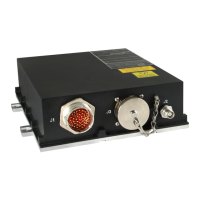INSTALLATION MANUAL
CMA-5024 GLSSU
This document includes Proprietary Information and shall not be reproduced or communicated to third party
without prior written permission by CMC Electronics Inc.
Page 105
November 21, 2008
B. GPS/SBAS Antenna Location
The GPS/SBAS antenna should be installed on the outer aircraft skin, along the aircraft centerline and
upward, such as the antenna will be nominally in a horizontal attitude in normal flight. Typically the
antenna will be installed on the forward topside portion of the aircraft fuselage in order to minimize the
shadowing effect of the vertical stabilizer and wings.
Good practice dictates to keep the GPS antennas segregated away from the other antennas, as far as
practical. This will provide good RF isolation from the various on-board sources of RF in order to
minimize the risks of RF interference. The following minimum separation distances are recommended:
(1) At least 160 inches (4.064 meters) from SATCOM, GLOBALSTAR or IRIDIUM transmitting
antennas.
Note: These systems transmit in the L-band at relatively high RF powers (up to 50 watts) at about 1620
MHz, very close to the upper end of the GPS/SBAS frequency band.
(2) At least 48 inches (1.219 meters) from TCAS communication transmitting/receiving antennas.
(3) At least 48 inches (1.219 meters) from VHF communication transmitting/receiving antennas.
(4) At least 12 inches (0.305 meters) from any other GPS antenna.
(5) At least one meter from any other transmitting antenna.
4. ANTENNA CABLE SELECTION
A. Theory
The overall insertion loss and the characteristic impedance of the RF transmission line must be
controlled, from the RF output terminal at the antenna down to the RF input connector J2 on the GLSSU
LRU, in order to maintain the expected system performance.
The antenna cable type and length and the attached RF hardware (connectors, adapters, bulkheads,
unions, etc…) must be selected according to the instructions below, prior to installation in the aircraft.
The transmission line design and the cable length must be adjusted so that the overall RF losses and
uncertainties (the sum of the individual contributions) stay within the maximum/minimum limits.
The insertion losses should include obviously the cable loss itself, but also the losses due to the RF
hardware and the power transfer uncertainties due to RF impedance mismatches (VSWR) and any
parasitic effects. The maximum insertion loss due to each RF connector pair is set conservatively to 0.1
dB. The allocation for VSWR and other parasitic losses is set to 1 dB; this allocation is consistent with
ARINC 743 attachment 9.
CAUTION: Do not insert conventional RF attenuators or resistive pads on the antenna cable, as a
means of adjusting the overall cable loss or for compensating for high antenna
preamplifier gains. These devices would short-circuit the antenna power supply carried
from the GLSSU on the center conductor the coaxial antenna cable, alongside with the RF
signal.
The document reference is online, please check the correspondence between the online documentation and the printed version.

